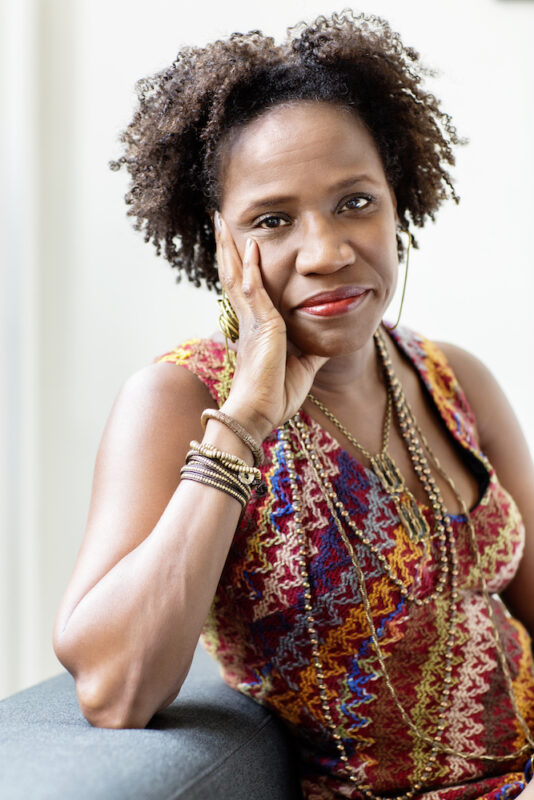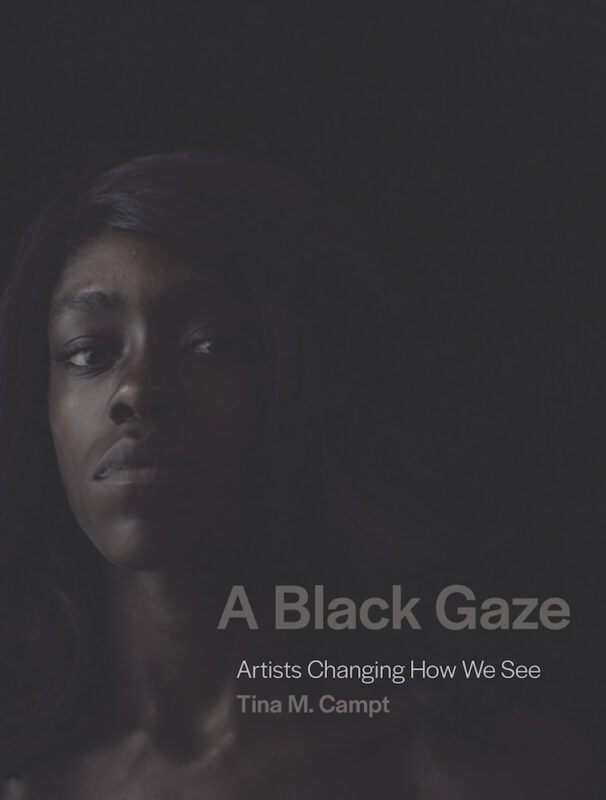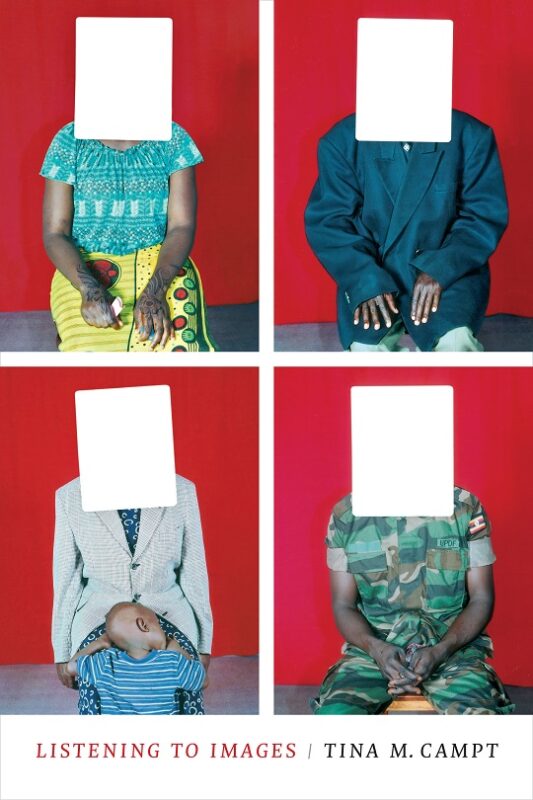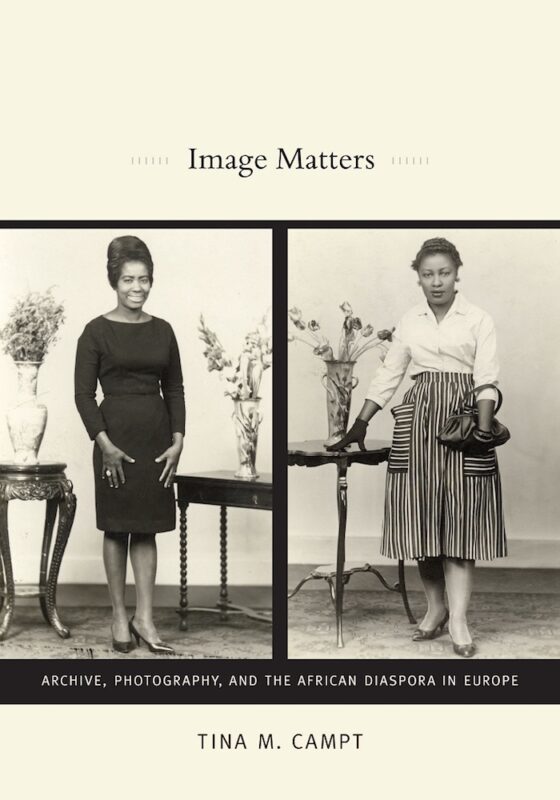Writer Conversations #1
Tina M. Campt
Tina M. Campt is a black feminist theorist of visual culture and contemporary art. She is Owen F. Walker Professor of Humanities and Modern Culture and Media at Brown University, Providence, Rhode Island, US, where she leads the Black Visualities Initiative at the Cogut Institute for Humanities. Her early work theorised gender, racial and diasporic formation in black communities in Europe and southern Africa, and the role of vernacular photography in historical interpretation. Campt is the author of four books: Other Germans: Black Germans and the Politics of Race, Gender and Memory in the Third Reich (University Michigan Press, 2004); Image Matters: Archive, Photography and the African Diaspora in Europe (Duke University Press, 2012); Listening to Images (Duke University Press, 2017); and A Black Gaze (MIT Press, 2021). She is the founding convenor of the Practicing Refusal Collective and the Sojourner Project.
At what point did you start to write about photographs?
I started to write about photographs after writing my first book, which was an oral history of the Black community in Germany in the Nazi regime. I started writing about photographs of these individuals because I was asked to do a sound installation on their accounts of their life at that period of time. What forced me to actually start writing about images is that when we did the sound installation, when we were designing it and trying to think through it, what I realised is that there is no way to get people to listen to anything without giving them a focal point to look at. It was a real challenge because I had strenuously avoided including photographs of the individuals who I had spoken to, because I felt that anytime I presented my work, someone in the audience would ask: “Well, what did they look like?”. “What did they look like?” became this way of indexing whether or not their account would be true, or could be true, based on how they looked, so that their race had to register in their bodies and on their faces in order for their accounts of their experiences in the Third Reich to be considered true. I had always avoided using photographs because I didn’t want to put those individuals and their stories in that position. But when I faced the challenge of having people be in a sound installation and to stop to absorb it, I started looking for their photos, collecting their photos [to do that].
After that sound installation, I was just so incredibly impacted by their photographs because they resonated with me so much, even though they were of families that were very different than my own. And I started writing about the photographs in order to give voice to the responses that I was having that I couldn’t explain. And it really was just an experiment because I never studied photography, art, history, any kind of visual culture in college or in graduate school. I strenuously avoided that as well, and these photographs kind of lured or tantalised me. They provoked me to try and articulate what they solicited in me, and that became a practice that, ever since I started writing, has been both terrifying and truly exhilarating.
Would you say that your writing is about that, that encounter? Recording an encounter, but also facilitating an encounter, mobilising it?
Yes, it is. I was just reading this morning about Generation X and suddenly realised that I am Generation X! I always thought I was another generation! In this article I was reading, I recognised myself because Generation X was the generation of MTV. We were the generation where images inundated us in a way that was unfiltered. And previously there had been so many more filters on images and their circulation. So, as somebody who from childhood – I got my first television when I was six years old, a tiny, tiny Sony Trinitron that my grandmother gave me – I have been inundated with images all of my life. At the same time, that has made me someone who can easily gloss over images because I’m so used to them being such a strong part of my life. With photographs, I had the exact opposite experience, which was that I couldn’t gloss over them. They grabbed me and I would just get lost in them. And so the practice that you’re talking about is really about trying to linger in that experience of encounter and to share it in a way that makes others linger in the same process. So that’s always been the motivation. It’s always been a little bit like: “Does this image do the same thing to you as it does to me?” And I’ve never expected a “Yes”, but the nature of my writing is to ask that question and to get people to think about the answers.
What is your writing process?
I had one practice and it’s changed more recently in the last couple of years. The first writing practice was with photographs, and it was about spending some time looking at a photograph, and then putting it away and writing about what I thought I saw, or what I thought I was experiencing in relationship to it, and then bringing the photograph back and reading what I wrote while looking at the image and seeing what I got wrong or what the gaps were. My next step was not necessarily to correct the gaps, but to write about where they came from, if there was a disjuncture between what I thought I saw and what I saw. I tried to articulate why that was; so why, for example, did I think that I saw a kid that looked really happy when the kid looked really sullen? There was something about me bringing something to that image that led me down that path, and I think that’s important, to not just write about images to describe them exactly. What I try and do is to describe a relationship to them that develops both through seeing and feeling, and allowing yourself to feel and respond. And so that sort of ‘look, look away, look, look away’ was the way in which I wrote about vernacular photographs.
Since I’ve started writing about contemporary art and film, it’s kind of changed. It’s become much more physical because I rarely have the images. I’m rarely in possession of them, or I rarely have an extended period of time with them. With contemporary art, I usually sit on the floor. I sit on the floor of the museum and just literally look and write, look and write, for as long as I possibly can, before people start to make me feel uncomfortable. I then take that away and go home and continue writing. I set this intention or aspiration. The first part of that process is ethnographic: I’m sort of writing about myself encountering an image or a piece of art. And then it’s about unpacking the rest of what that relationship looks like, like what are the larger contextual things? And then, more recently, I’ve started writing about film and that has also become this extraordinarily spatial and haptic encounter, where I usually have to set up my computer with a sound system that will allow me to have contact with the audio, because the audio and the visual are so intertwined that I need to be able to feel the sound of a film. This is much harder for moving image; it’s harder to write in relationship to, and so I find it to be a really tedious process where usually I have my computer and I have an iPad and then I’m typing and I’ll pause and then I keep typing. It’s literally simultaneous to the moving of it, and once I get the whole thing down, I re-watch it, and then I’ve usually memorised the actual film by the time I’m done, and I can tell you what it is, frame by frame.
What are the questions or problems that motivate your writing?
That has also shifted over time. When I first started writing about the family photographs with Black German families, what motivated me to write about them was trying to account for visual intimacy at a moment or in a circumstance where that seemed impossible. Those photographs were able to capture care, intimacy and relation in ways that I had never seen written about before. I carried that forward into writing about the vernacular images of the Black British community (the Afro-Caribbean community in Birmingham), where, in their staged photographs, I found a level of identity that was expressed so profoundly, and so profoundly beyond words.
That was a moment in time when I was thinking about “what do photographs allow people to do, or to say?” That was really the question of Image Matters (2012): what do they help us to do, or to say when we don’t have the other resources to do or say that? When I was writing about compelled photographs, it was the same question: what do these images allow those individuals to do and to say beyond what the state is telling them to do and to say through their image making.
More recently, the question that that has motivated my writing is how does the work of contemporary artists challenge us to see our world differently and to see it by feeling our implication in some of the injustices of this current moment? Those artists’ lenses – and those lenses can be cameras, can be clay, can be a stage, can be can be all sorts – give us a frame that takes us outside of ourselves and puts us in proximity with things we don’t want to be in proximity with. And so the question I have had is: how do they do that? How are they able to put us in proximity to things that we don’t want to be proximate to, and how does that change us in the process?
What kind of reader are you?
I’m a bad reader! I am the reader I tell my students not to be, which is I skim. It’s a kind of excavation. I read really quickly and I’m searching for something, and when I find it, I read it over and over and over again. It becomes a wormhole. I got my PhD in History, and I was trained to be a reader of footnotes, and so I’m somebody who, once I get there, that sends me elsewhere to find all these other things. My synapses start going. And so I am both the reader that I tell my students not to be, which is to skim, and then I am who I tell them to be, which is to read openly and capaciously and connect the dots, and read people who are in conversation with each other. I tend to read in clusters.
How significant are theories and histories of photography now that curation is so prominent?
You know, the thing that is most noteworthy to me is that curation and theories and histories of photography are completely intertwined, because we are at a moment when the curators themselves are so deeply invested and so deeply conversant with those histories and theories. There’s a sort of changing of the guard. I don’t know if it’s the same over in the UK, but in the United States over the course of the pandemic, everybody seems to be moving: curators moving from here to there to there, and there’s been this reshuffle and it’s exciting because so many are new curators, young curators and curators of colour – they are people who didn’t come out of the art world; they come out of a world of critical theory around photography and the practice of art.
You see it in wall texts and in catalogues where the curators are referencing different theories and histories and are trying not only to put photography in conversation with genre, which used to be the way. Every curator was an Art Historian; that’s what it used to be. That isn’t the case anymore. It used to be that a catalogue would give you a kind of genealogy of the genre, of the form, of the content or context. And now I feel that curators are actually invoking the language of theory in order to talk about the impact of the work. They feed on one another.
The other thing is that photographers and artists are more steeped in theories of photography than they had been, and that’s another ongoing conversation. I’m finding right now that one of the delights of my work is that I am being asked more and more often to be in conversation with artists, who know my work, and I know their work, and those two things are no longer separate. It used to be that the history and theory of photography used to write about photography and photographers. Now we’re talking to them, and they’re talking to us, and it’s not an argument, it’s a conversation!
The leading art schools (in the US) like Yale, RISD (Rhode Island School of Design) and Cal Arts (California Institute of the Arts) have theorists amongst them and that is recognised as valuable, and I have felt that. I do at least one art critique at the end of every semester, where somebody asks me to come to their studio class and participate in a nine-hour critique, which is exhausting but I also learn so much from that!
What qualities do you admire in in other writers?
I always admire clarity. I admire the writer that doesn’t only seek to draw you in to their writing, but also takes steps towards you in their writing. Some of the most inspirational writers to me are friends of mine, whose work has been a model and an inspiration. Christina Sharpe’s work, Hazel Carby’s most recent work, Imperial Intimacies (2019), my friend Saidiya Hartman. What they’re doing is they’re putting themselves in the mix, and, in doing that, they’re emphasising the stakes of both what they’re writing about, and how they’re writing about it. The “how” becomes an intentional intervention, of: “I am going to write this to you, in a way that addresses you, which doesn’t make it easier to read what I’m writing about, it raises the stakes of reading it.”
That’s what I really do admire, and that’s what I try to do in my own writing, is to let you understand what the stakes are of both what I’m writing about and how I’ve chosen to write it to you. Which I hope allows you to enter it, and take certain risks as well with your own engagement.
Which texts have influenced you the most?
Some of the writers I’ve just mentioned. I teach (Christina Sharpe’s) In the Wake (2016) over and over again. I teach (Saidiya Hartman’s) Wayward Lives (2019) over and over again. I also teach Laura Mulvey. Right now, I’m in a love affair with Laura Mulvey and Kaja Silverman: not because I absolutely agree with what they’re saying, but because they open my mind every time I read them. bell hooks I teach over and over again, and I read her over and over again. Fred Moten as well. And you know who else I can’t quit? Stuart Hall! Can’t quit him! Ever relevant. Every time you go back to him, you really you can’t believe he wrote it so long ago.
What is the place of criticality in photography writing now?
I hate to answer a question with a question but it really does depend on where that photography writing is. One thing I’ve been noticing is that there’s a lot more general writing about photography, in newspapers and in reviews, in daily circulating publications, and I don’t find that critical very often. But again, I feel like criticality has taken a front seat in the art world, among curators, amongst this entire Third Estate that’s no longer journalism. So I guess it’s a Fourth Estate, which is the critical commentary that you get in blogs and in podcasts and on social media, because the general public is at a point right now where they feel empowered to critique and to critique photography in particular. I think that’s also because of the role of photography in documenting the horrible state that the world is in right now, be that on race relations and social justice, or the pandemic, or immigration, or housing. Those images are mobilising and, at the same time, they are documenting certain kinds of injustice. (They record) not only the acts of injustice, but the acts of injustice that the camera perpetrates as well. So it has become this invitation to a broader form of criticality than used to be prevalent.
I wondered whether you could talk a little about the importance of everyday experience in relation to your writing. Your writing reveals how a seemingly modest image contains so much possibility and all that it starts to bring into being. Your writing is drawn to the necessity of thinking through everyday experience, and its representation.
The importance of the everyday, for me, is that our most intense struggles occur in the everyday. There is a desire in me to be accountable not to the extraordinary, but to the ordinary. And when we’re accountable to the ordinary, then we are valuing the experiences of those who rarely get much attention. When you ask about its significance to me, I think that’s how we learn practices of survival. We don’t learn practices of survival in the extraordinary circumstances of a car crash or a plane crash, or being marooned on an island. We develop these strategies incrementally over time. That’s what I see in everyday photography and vernacular photography. When I come to those images, I’m always asking how did we get here, and what is it that connects us to mundane images: in their mundane-ness, you find these jewels, these jewels of love, of kindness, of generosity, of care. And you find the flip side too. You find the quotidian violences that are also brought to bear. There’s this image in Image Matters that I try to take apart, of a woman on a table in a corner. When you take it apart you realise that she’s in a gynaecologist office and there’s a procedure that happened or didn’t happen. Every woman has been in that situation, but to have an everyday photograph of it, an anonymous one… When I saw it at an exhibition, I just stopped in my tracks. It’s not because it was exceptional, it’s because it was so ordinary. We can illuminate so much about our lives by lingering in relationship to the ordinary and thinking about how we survive it and how countless other people survive it as well.
Listening to Images made me conscious of how the stakes are there in the image of the everyday. Perhaps this is what’s most resisted by positions of power? They are the most essential images in a sense, to just be seen, to be seen to be living, to be loving, to be sharing.
That is one of the tricks of ideology: to highlight the exceptional as that which you are supposed to be striving to be or become. That then becomes this impossible striving towards something you can never accomplish. And it keeps you in your place. But when you value who you are, it becomes a powerful source of identification and affirmation. And that’s my resistance to the exceptional: I don’t want to be exceptional. I want to share a world with others where we have some sense of equivalence. I think that’s a beautiful world, as opposed to the one where there are some who are exceptional and others who are not.♦
Further interviews in the Writer Conversations series can be read here.
Click here to order your copy of the book
—
Writer Conversations is edited by Lucy Soutter (University of Westminster) and Duncan Wooldridge (Camberwell College of Arts, University of the Arts London), upon the invitation of Tim Clark (1000 Words and The Institute of Photography, Falmouth University).
Images:
1-Tina M. Campt © Dorothy Hong
2-Book cover of Tina M. Campt, A Black Gaze (MIT Press, 2021)
3-Book cover of Tina M. Campt, Listening to Images (Duke University Press, 2017)
4-Book cover of Tina M. Campt, Image Matters: Archive, Photography and the African Diaspora in Europe (Duke University Press, 2012)




